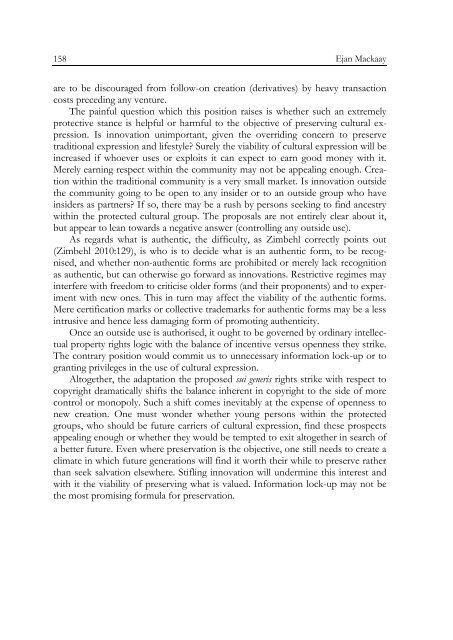Sui generis Rechte zum Schutz traditioneller kultureller ...
Sui generis Rechte zum Schutz traditioneller kultureller ...
Sui generis Rechte zum Schutz traditioneller kultureller ...
Sie wollen auch ein ePaper? Erhöhen Sie die Reichweite Ihrer Titel.
YUMPU macht aus Druck-PDFs automatisch weboptimierte ePaper, die Google liebt.
158<br />
Ejan Mackaay<br />
are to be discouraged from follow-on creation (derivatives) by heavy transaction<br />
costs preceding any venture.<br />
The painful question which this position raises is whether such an extremely<br />
protective stance is helpful or harmful to the objective of preserving cultural expression.<br />
Is innovation unimportant, given the overriding concern to preserve<br />
traditional expression and lifestyle? Surely the viability of cultural expression will be<br />
increased if whoever uses or exploits it can expect to earn good money with it.<br />
Merely earning respect within the community may not be appealing enough. Creation<br />
within the traditional community is a very small market. Is innovation outside<br />
the community going to be open to any insider or to an outside group who have<br />
insiders as partners? If so, there may be a rush by persons seeking to find ancestry<br />
within the protected cultural group. The proposals are not entirely clear about it,<br />
but appear to lean towards a negative answer (controlling any outside use).<br />
As regards what is authentic, the difficulty, as Zimbehl correctly points out<br />
(Zimbehl 2010:129), is who is to decide what is an authentic form, to be recognised,<br />
and whether non-authentic forms are prohibited or merely lack recognition<br />
as authentic, but can otherwise go forward as innovations. Restrictive regimes may<br />
interfere with freedom to criticise older forms (and their proponents) and to experiment<br />
with new ones. This in turn may affect the viability of the authentic forms.<br />
Mere certification marks or collective trademarks for authentic forms may be a less<br />
intrusive and hence less damaging form of promoting authenticity.<br />
Once an outside use is authorised, it ought to be governed by ordinary intellectual<br />
property rights logic with the balance of incentive versus openness they strike.<br />
The contrary position would commit us to unnecessary information lock-up or to<br />
granting privileges in the use of cultural expression.<br />
Altogether, the adaptation the proposed sui <strong>generis</strong> rights strike with respect to<br />
copyright dramatically shifts the balance inherent in copyright to the side of more<br />
control or monopoly. Such a shift comes inevitably at the expense of openness to<br />
new creation. One must wonder whether young persons within the protected<br />
groups, who should be future carriers of cultural expression, find these prospects<br />
appealing enough or whether they would be tempted to exit altogether in search of<br />
a better future. Even where preservation is the objective, one still needs to create a<br />
climate in which future generations will find it worth their while to preserve rather<br />
than seek salvation elsewhere. Stifling innovation will undermine this interest and<br />
with it the viability of preserving what is valued. Information lock-up may not be<br />
the most promising formula for preservation.

















